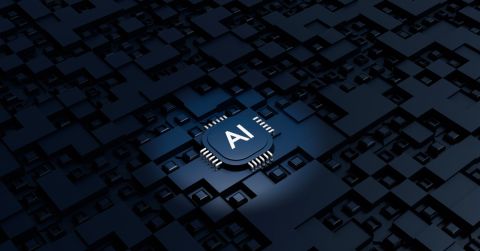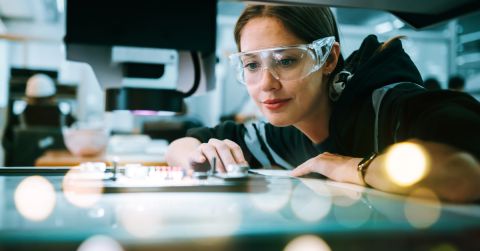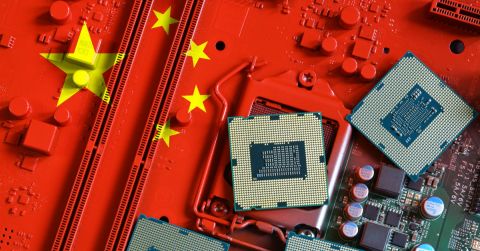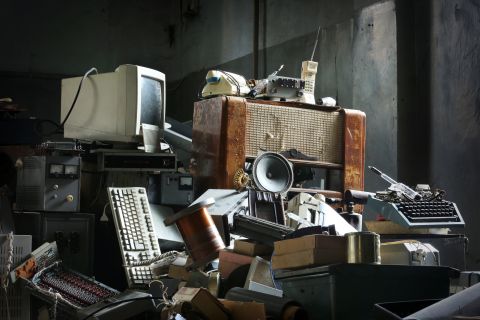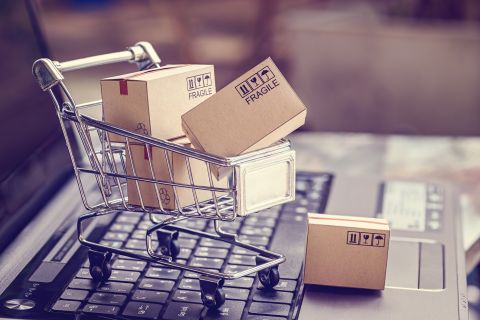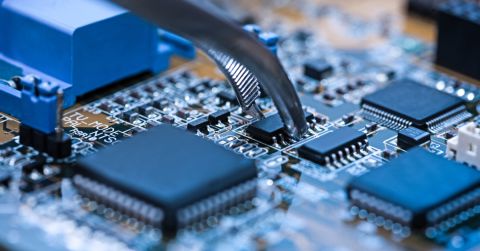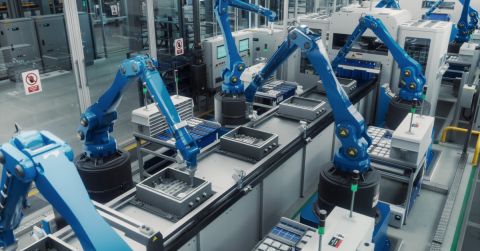Linear & Rotary Actuators: Revolutionizing Industries

Discover how Bishop-Wisecarver is leading the charge in revolutionizing industries through the innovative use of linear and rotary actuators. Join hosts James and Joseph on this episode of the CTRL+Listen podcast as they dive deep with Pamela Kan into the fascinating world of automation solutions. From MRI machines to the Hubble telescope and beyond, learn about the critical role actuators play in everyday life and the future of technology.
Explore the challenges and triumphs of maintaining a reliable supply chain, the impact of COVID-19 on manufacturing, and the promising horizon of material science in space. This episode is a must-listen for anyone curious about the mechanics behind the movement and the future of engineering.
Listen to the Episode:
Watch the Episode:
Episode Highlights
- Supply Chain Compliance & AI
- Legislation & Industry Growth
- Working in Tech as a Woman
- How AI's Being Integrated Into Mechanical Processes
- Workforce and Demographic Challenges
Links and Resources:
Transcript:
James: Hey, everyone, this is James from the "Ctrl+Listen" podcast brought to you by Octopart. Today I'm joined by my co-host, Joseph Passmore. We have a special guest for you, Pamela Kan, working with the company Bishop-Wisecarver. They do some pretty exciting stuff in the space of automation solutions. You may not have heard of it as it's quite particular, it's linear and rotary actuators. Thanks for coming on the show. Great to have you on.
Pamela: Thank you. Thank you for the invitation. Happy to be here.
Joseph: Great.
Pamela: Excited.
James: And do you wanna sort of explain to people what exactly this all means?
Pamela: Sure. We're pretty basic, actually. It sounds very fancy, and almost like you don't really think much about your zipper in your clothing, but it's the same thing for anything that moves. So we are inside machines, processes, buildings, things that have to move back and forth, up and down, and around. So an example most people understand, 'cause they've seen it in TV or had one, is an MRI machine. So if you think of the MRI machine, you sit on the bed of the machine, which slides in and out, that would be a linear actuator. And then a magnet spins around you to do the imaging, that's a rotary actuator. So we don't necessarily make the whole machine, but we work with machine makers to design the movement of the machine, or the process, or the building. So from moving big walls, windows, vents, doors in a building to doing process automation equipment, machines, lab equipment. We're in all different type of industries, 'cause if you think about it, almost everything has to move to make the product, or convert paper, if you're gonna fold up for a 6-pack, 12-pack of Coke, that paper has to be converted and folded. All those machines have to move, we design that movement in the machine, and allow the machine to do the movement.
James: So it's one of those things where this is touching people's everyday lives without 'em even realizing.
Pamela: Yeah, yeah. And then our niche is harsh and extreme environments. So we are aware it's a very contaminated environment. So pulp and paper, food processing, very actually contaminated, lots of debris, metal chips, wood fiber, food parts, that type of thing, to being out in environment that's actually very extreme like space where it's extremely cold, lack of gravity, all of that, so like the Hubble telescope to we're out in a very hot environment like we do landmine detection devices, so you're out in the desert, the sand, the dirt, we're moving into the field automation space. So robots that are out doing row farming through automation and AI. Once again, it's wet, it's dirty. To the other side would be like lab automation, as I said, like an MRI machine, or lab equipment, you want it to be very smooth and very quiet. And that fits our technology as well. So we're kind of in all the extreme environmental plays.
Joseph: How does BWC manage its procurement process to ensure a smooth and reliable supply chain?
Pamela:That is the million dollar question, especially since Covid, correct? So one thing that we're lucky is that we actually with, so I'm second generation, my dad started the company, and then I've taken over. So we're going into our 74th year now. We basically have all bespoke equipment to do our core products, so it's all machinery that was originally actually built by my dad, and what's great about the way he built the machines is that being a machine builder himself, we have always been a process, have processes here that allow us to customize solutions for our customers, even for one piece, and we can do that profitably. So what was good about that, and having our internal processes set up that way, we could pivot really fast during Covid. So we could change, a lot of our customers change, 'cause in Covid all of a sudden it was about food and medical customers during Covid, and we could change our processes to support that. And we also have very long-term supply chain partners. And having those real deep relationships with our supply chain, once again, allowed us to pivot with them, change what we needed in order to support customers, but I would say we were also very lucky in that we only had one product line that came outta China. So the whole shutdown with China really never affected us. We are a little bit unusual, most linear or automation companies tend to be Europe, or even if they're here in the US, they are east of the Mississippi. So we're unusual, we're out here in California, so that did give us some challenges with the ports. So we did have some delays getting things around through the Panama Canal into the port of either LA Long Beach or Oakland, so that did give us some challenges, but we have quite a few strategic sourcing partners here in North America, and that was really key for us during the pandemic, 'cause it was already within the country.
James: I was actually gonna ask you about this later on, but it's come up now as a topic, so I'll ask it now.
Pamela: Yeah, yeah.
James: What impact do you see coming from this trend since Covid of reshoring and nearshoring manufacturing supply chain operations in the US?
Pamela: I think it's just growing. I just came back from the A3 Business Forum, so that's the big automation industry association for us. I think if you follow Peter Zeihan and any of his books, I think there's definitely a trend away from global supply chains, getting it as close as possible to home. I know for our large OEM customers here in the US, they want things as near-sourced as possible. You hear about the two-hour window around a plant, which we achieve that through distribution partners here in North America, but we are working on trying to source as much as we can for our products now in North America. Even floating it on a boat from Europe is getting harder and harder, the cost is still very, very much in flux, the separation of Brexit, we have a major partner in the UK from the EU has created a bunch of complications. And then there's the growing regulatory is making it very complicated now. With a rise of ESG, all the different EU regulations, plus I'm here in California, all of our environmental regulations, it's a full-time job staying on top of like RoHS, all the certifications. Managing supply chain is just getting more and more complicated. So the more you can have it close to home, the better.
James: Yeah, we were just actually talking with another guest who came on the podcast recently about how important visibility is becoming in the supply chain. And so it's just to be something that's become more and more prevalent as we progress down this path of legislation.
Pamela:Yeah, especially with recent regulation outta Europe, it's pretty much not an option. We spend a lot of time filling out that paperwork. So I mean this once again goes back to it's good that we have really long-term relationships with our supply-chain partners, because it's a lot of work dealing with all the compliance. You have to verify all your metallurgy, you have to go all the way back through your supply chain, the whole verification of labor, no slave labor, all of that. It's a full-time job. Compliance around supply chain is definitely becoming a full-time job. And now we're just gonna rise above that with ESG. So now you have all your goals around your supply chain, your environmental goals, now you have to publish that in your ESG policies, then you have to certify that, you have to audit that. We just came on with EcoVadis and they're going through and auditing, but it's a lot of administrative paperwork now to verify your supply chain to your customers. But more and more want it. If you wanna play with the larger OEMs, you have to have it.
Joseph: Is supply chain compliance and certification an area in which you see AI being able to help lighten some of this workload?
Pamela: Gosh, I hope so. I mean, I think the problem right now it's a little bit of the Wild West, and this is just my opinion. We don't really have, even when it comes to ESG, there really isn't standards, right? This is about being a corporate good citizen, people are putting it out there, they're starting to audit and live up to their ESG policies, but it's all about benchmarking. So in my state, I'm sort of required to have certain benchmarks from a regulatory process, which is different than somebody who might be in Illinois, and it's different from somebody who would be in Germany. So part of the problem is there isn't a worldwide standard yet around ESG and what the benchmarks should be. Everybody has different benchmarks right now, and you have a whole rush of companies coming in to be sort of auditors like the EcoVadis and other players like that, and they're all doing it differently, they all have different benchmarks that they're looking for. So I'm assuming over time that will settle out, and it'll start to be easier to know what you really have to do, but right now it's very much a little bit of a free for all from my experience.
James: It's interesting because this seems to be a problem across the board with legislation. It doesn't ever keep up with the growth that industry moves at. I used to work in legislation back in the day, and it's always a couple of steps behind where it should be as far as keeping up with progress. So yeah, it's just one of those things.
Pamela: Well, and I think it's also keeping up with technology, and I think part of the problem is lawyers and regulators don't know technology. So sometimes I think they hear things and they think that it's an easy thing to comply with, and they don't know the realities of actually putting the technology in place to get to that compliance level. I see that a lot in California. We take pride, we wanna be one of the leaders in the world in environmental policies, but they don't really understand the real-world implications of being able to achieve that standard, and what it would take. And then, like here in California, we have all different agencies. So this standard gets monitored by this agency, but this standard is by this agency. But if you go out to the laws like recently passed here in California, so we have a new, it kind of supersedes ESG for us. We have to do all this reporting, we're gonna have to report it to CARB. There's not even enough people at CARB to manage the regulation passed. And there still isn't clear standards. So they passed a law, the agency that's supposed to monitor it doesn't even have enough people to monitor it, and no one's still clear really what the standards would need to be.
James: I wanted to change topics slightly and just ask you about something that's probably gonna be a little more personal for you. But working in this industry as a woman, have you found there to be additional hurdles that you've had to, I guess, face to be where you are today?
Pamela: Well, there's definitely hurdles. The subject came up even at this last conference I was at, and it's coming up more and more. I think I might be a bit used to it because I grew up with three older brothers. I was always in the minority, even in my own family, right? I always struggle with this question. I will just tell you my own experience is I think being a woman in this industry can be as much a benefit or a hindrance. And I think depending on how you wanna leverage it is what it is.
Pamela: Meaning, I rarely talk about being the only woman in the room, or just a handful. I don't spend time worrying about that, and so therefore it doesn't seem to limit me. I'm in other rooms where there's women or minority who really make it a central topic, and then it seems to create a lot of friction. And I don't know, I think your energy goes where your attention is. I don't spend a lot of time focusing on that. I figure there's tougher hurdles than that. And I have found in my career, men are very accepting of me. Most of my mentors have been men, they've been great supporters of me, my career, my company, so I cannot say I've faced a lot of that, and let me preface that here in America. Now, I will say it can be different for me in other countries around the world, but at least here in North America, I don't feel a real issue. And that might be a surprise answer.
James:No, it's refreshing. Everyone gives such a different response to a question like that. So I appreciate the honesty, thank you.
Pamela: I don't know, I think if you come into a room prepared, there's not really any barriers.
Joseph: I was gonna ask about on the subject of back to AI and software, how they are being integrated into the mechanical process in your plants?
Pamela: Yeah, it was interesting, one of my takeaways from being at that meeting last week is that our specialty is the mechanical side, and I think what you're seeing in our industry is getting the mechanical technology up to speed with the AI technology. AI and the software has just really expanded, and doing the software in some ways is faster and easier than matching it up to the mechanical. So there's actually a really great video that's been released by, who has Spot the robot? Boston, Boston Dynamics? Is that it? Do they make Spot?
James: I think so.
Pamela: Sorry, I'm having a mind fart right now. But anyways, they've just released a photo, or a video, teaching integrating AI into Spot, and into that robot, and it's fascinating. But like I said, the AI is a little bit ahead of where the mechanical part of the solution can be. But I think as they come together, as we get IOT 4.0 out on our floors, and there's so much data, and there's so much knowledge now on the AI stuff, I think everything's gonna start to just go faster and faster. I think a lot of it's just gonna be about managing all the data you can start to get, I mean we're using ChatGPT every day now in our business model. But actually embedding it in all of the mechanical solutions is a tougher thing to do. I mean, that's still lagging. But I think the use of AI will definitely happen faster in those areas like customer service, sales, marketing, analyzing the data, as you run these sensors off of the floor, you have a massive data lake, and that's where AI can come in to start helping to digest that data in a more intuitive, faster way.
James:The data analytics has been absolutely exploding in the last few years, it's crazy to see that growth.
Pamela: Yeah, but it's great. And now that ChatGPT has gotten to the part from a privacy standpoint where you can start to actually have your own sandbox so you need ChatGPT to get to know you and get smart, but prior to the end of the year, depending on your usage of AI, you were actually sharing that with everybody, there wasn't a lot of privacy. Now you can create your own corporate sandbox. This is when it's gonna really start to explode, because I can create my own ChatGPT for my technology. And as we use that, and we put more and more of our data into it, it's gonna get smarter and smarter, and it's gonna help us do everything faster and faster and more efficiently. I think it's gonna be great as when we get to have smart enough AI, it should speed up our prototyping, our product development, all of that will be able to go much faster. And then the tools we can give our customers should be much more intuitive and easier to use as we get all of our application engineering knowledge into a chat bot. Now it's just not the one application engineer you get, which is great, and we offer that type of service, but you could go into a chat bot and get all of our engineering knowledge, and go through asking questions, and that's gonna be really, I can't wait for that, that's gonna be cool, that's something we're starting to build now.
James: Exciting.
Pamela: Yeah.
James: I guess, how has your company shifted the way it operates as far as supply chain in regards to just-in-time? Has that shifted at all?
Pamela: Well, what I said, what I used to say is that Covid killed just-in-time, right? And so prior to Covid every manufacturer wanted to be lean. Every manufacturer, lean Six Sigma, you're trying to have as few parts on the shelf as possible, you want as many turns as possible, that's all your money, can't have your money sitting on the shelf. But you also have to be able to sell a customer what they want, when they want it, right? That's the tension of just-in-time. And so, I mean, I will tell you even now we have about twice the inventory on our shelves as we did going into Covid. It's just the reality of how supply chain, I mean if anybody's done the Beer Game, if you've done NBA work, you've played the classic Beer Game. Well, we all lived out the Beer Game in Covid, and we saw what happened, you start to push on one area of supply chain, and now we saw it all in Target, right? It was all the wrong inventory at the wrong time. We all played out that game, and saw the impact of what happens when you start putting pressures on different areas of the supply chain. It's smoothing out now, and I would say that was definitely what we saw in 2023, is everybody in our industry was sitting fat on inventory, and you've gotta bleed it down, 'cause you can't have that many dollars on the shelf. So I think there's a tension now, it'll be interesting to see how lean people take their inventories now after going through that, because I think we still have a war going on in Russia and the Ukraine, which is affecting things. I know if you've read the news lately, but piracy of ships is going back up. So floating your inventory on a big boat is getting a little more and more precarious as the waterways are no longer as safe and open as they used to be. All of these things start to affect the supply chain. Messes in the Panama Canal, that affects things, so all these lead it to, it's harder and harder I think to run a just-in-time process. I think theoretically it's all what we aspire to do. I think practically, with the way supply chain is still working in the world, it's still hard to see going back to inventory being that lean. But depending on the rise of additive manufacturing, that will be the savior. When additive manufacturing, or what people call 3D printing, as that gets better and faster, as that can be done with more and more materials, that's going to take some of that supply chain pressure off. Still for me, I still can't do what I need to do, because our standard length of rail is 20 feet. Printing something in metal, 20 feet long, guys still laugh at me when I try to find people who will take on that challenge. When we get there, it'll totally disrupt supply chain altogether. And I think people, they have a sense of 3D printing from seeing things on TV, especially on the polymer side. I think people don't understand how long it takes. That machine's printing one part, usually, and it normally runs that part in hours. You set up the machine, you go away, you come home in the morning, come back in the morning, and the part's done. It's getting faster and faster, but especially with metals, you still have hardening issues, you don't have a final product, so you still have to do second or third ops. But as that technology gets better, that will only help supply chain. When I can print more and more of what I need here, it'll also help on the environmental side, way less scrap, right? Right now I'm doing a reductive process, taking a piece of billet or whatever, I'm taking metal away, it's creating scrap, all of that. When we can get where we need to go with additive, it'll completely change supply chain. But we have a ways to go. It's going fast, but there's still a ways to go, especially on the metal side.
James: We've seen the progress that's happening in the PCB space, the ability to prototype and print those saves so much time, like developing new equipment, it's crazy.
Pamela: I mean, and that's right now we use it a lot for our own prototyping, we print all of our fixturing for our machines way faster. That's completely sped up that process for us to be able to print all our own fixturing in-house.
Joseph: Apart from 3D printing, do you see any other emerging technologies or approaches that are gonna shape the future of mechanical engineering?
Pamela: I think the material sciences are gonna really change things. More and more you're starting to read more about materials, refining new materials, new blends, but I think when we figure out how material sciences, I think they're realizing will really explode with being able to do them in space. I just read an article about this in "Scientific American". And then HBR last year had a big thing on do you have a policy for space? And I think whether you're looking to sell into space, there's manufacturing starting to happen in space, think we've got a lot of satellites up there, there's a lot of things starting to happen in space. But when you take material sciences, and you start to grow, you can grow these materials in a space environment, there's things you can do in space that you can't do on Earth, or you can do 'em faster in space, actually, because of the environment. I think that's really gonna change a lot of things around material sciences. And that's really exciting, I think. I'm looking forward to that.
James: It's interesting because it's gonna devalue a bunch of precious metals once they figure that out. 'Cause we had someone on the show once who works in that space, does 3D printing and actually works in space, and he was saying that diamonds, once they figure it out with diamonds in space, they're gonna be able to just massively generate them there at a fraction of the cost and the duration of mining. It's exciting.
Pamela: Well, they're even now, I mean, the speed they can grow a diamond is getting better and better, and it's a much healthier, I mean, growing diamonds is better than mining diamonds
James: Definitely.
Pamela: for a lot of different reasons.
James: Yes, we'd love to speak about the workforce side of things, we haven't really covered that. We have time.
Pamela: Sure.
James: So what would you like to tell us about workforce from your perspective?
Pamela: I mean, I think we're up against the demographic challenge with workforce because in general we're having less babies in the world, so every country has less and less young people, the US probably from a population standpoint, if you listen to like a Peter Zeihan or whatever, has one of the best demographics, but it's still much smaller than the baby boomer. So we just have less workers. So once again, that's good for automation, it's good for what I do, it's good for robots, all of that, and it's great that we have the technology to supplement our workforce, but it does mean we need a more and more technical workforce. And I think this is where we need to really look at the educational system, because if you take like my dad, back when he was going to school, he had art class, and he had machine shop class, and a word working class, and an automotive class. He had a bunch of applied learning where he could go to school and he could actually try out building things, or designing something, or being creative. It was hands-on, applied time. Most of our public schools have taken a lot of that out of their curriculum. And so I think that has really put our kids at a disadvantage, which is why we've been big on supporting things like FIRST Robotics where the kids can come together, number one, they learn to work in a team, they learn how to be collaborative, learn how to solve problems, but they get to physically build something, and they learn how to prototype, they learn how you might try putting something together and it might not work, and it might break, and you have to go back, and they learn how to think in sprints. And these are all really critical skills coming into what the workforce will be like in the future. And then I think we have still the classic challenge with women. The studies show that if you haven't engaged a girl in STEM-based education by sixth grade, statistically, it's very unlikely she will get involved in a STEM-based career.
James: Interesting.
Pamela: Even if you engage her by sixth grade, you now have to make sure through middle school, high school, and college, where there is a lot of pressure, this is I think where most of the pressure lies with women in this space to stick with it. So many, many young girls, they won't make it through college. They'll drop out at some point. And that's the main thing, so we're just producing less degreed STEM-based women. It's getting better, a lot of the schools are really trying to see how they can nurture and keep them in there, in the STEM-based educations, but that's really the challenge, the challenge is really getting them interested. I saw something recently where a gentleman was showing how he gets up every morning, and he plays with his two sons, and they play with robots and Legos. And I did have to think to myself is if he had two daughters, would he be doing that every morning with them? Just asking, maybe he would, but that's what makes people have a confidence and a comfort factor as a young girl that, hey, I wanna build things and I should build things, and it's just as much viable for me to build things as for a boy to build things. And when we can change that, I think that's what will change, because if you think about it, if we have less viable workers, and now really only one sex has most of the degrees, now you've just chopped the workforce down even more. So solving the workforce dilemma is actually making sure everybody is getting the same opportunities to be engaged and grow their technical skillsets.
James:Coming more important than ever as well, because we've got this massive shift of manufacturing back to the US, but we have a massive shortage of specialized workers who can actually operate this machinery, and by 2030 they're saying it's gonna be a crisis. So we really need to find ways to remedy that, and this is a fantastic one right here.
Pamela: Yeah, I think the other one, which is strictly a biological one is, well, and maybe this will change with technology, and it is to a certain degree, but women still primarily are the only way to have children, which means maternity leave. And that is still a hurdle, I think especially in tech and manufacturing. It is hard for a woman in a STEM-based career to take that time off and have it not impact her career. And we need to figure out how we lessen that burden, once again, on one person's career trajectory, because I mean, it is the primary way that we keep our species going, and a lot of women pay from a career standpoint a big price for that.
Joseph: I know that in France they have as well as maternity leave, I believe you have six months where you can leave your job, and you have the right to return to the same job at the same level guaranteed by law. Which seems...
Pamela: Which when you're a very large company,
Joseph: to put people back.
Pamela: it's much easier to support than when you're smaller. I mean, even in our company, we have a lot of positions of one. So if you have somebody out for six months, how does that job get done? So it works when you have thousands of employees, it's harder when you have hundreds to support those type of policies, and I think that's part of the rub. And technology also allows you to make your products with less people. So it's kind of a constant friction, right? Yeah.
James: A balancing act.
Pamela:It is, it is a balancing act for sure.
James: Great, were there any other topics you still wanted to cover? I think you mentioned a couple there. Did we get through all of them?
Pamela: So the workforce development crosses with AI and the digital transformation in that as the cost of technology and the tools around, especially like AR and VR, get cheaper, more commonplace, easier to create and program, it's going to really change the speed of on-the-job training. Because as you can set up those virtual spaces, once again, it gives you a sense of hands-on. So you can go into that space, you can get walked through doing that process, learning how to make that part, run that machine, whatever, that is going to be another way where technology is gonna have a big play with how we train and develop our workers going forward. And like I said, as the cost and the complexity of creating those virtual spaces come down, I think you're gonna see that as being very common that when you go to learn a job, you're gonna actually do it in a virtual reality. And I guess like "Grand Turismo", right? We found out playing games and actually, I mean, that's why I'm saying the technology is getting so good that when you can learn to master something in even a virtual or augmented space, it has direct skillset applications, and it does transfer over, and so I think that's another real exciting development to see come into especially the manufacturing space.
James: It's funny you mention that 'cause literally yesterday we published a podcast episode we did about this exact topic.
Pamela: Oh, okay.
James: Yeah, about how important it is in training now, it is gonna become a available tool to actually train people to using fully-augmented reality training programs. It's very exciting.
Pamela: And what's great, especially when you don't have to have a special room or a space for it to happen, when it can start to happen over distances, that's really gonna be great.
James: Right, and the thing they mentioned is, when I think about if you have specialized equipment you have to train on, you don't have to have that specific equipment with you to actually learn that.
Pamela: Right, and I think the other thing is as the boomers and Gen X's start to retire and leave the workforce, we're losing a lot of knowledge in our work base. And that's the other thing every manufacturer is struggling with. So this is where once again, that AI getting all the data, so as you're able to actually get the data, get the training, get the knowledge out of these workers into these virtual training environments, you're allowed to preserve that. You can preserve that knowledge base even as workers start to retire, and you don't lose it. And then I know for many of the machines out where, 'cause we do grinding, we do heat treating, you'll hear a lot of times my team out on the floor, they'll say, ah, but that machine's an art, right? It's about a feel, you can't just say, you set it up to this and this, it really takes a sense of intuitive knowledge of the machine, it's a bit of an art to really run product through at the optimal level, and the more you can get that into a technical knowledge base and train on it, the faster you can get the next worker up to producing that part as fast as possible without a lot of scrap. Learning to do it, because scrap is expensive, yeah.
James: Yeah, I mean this is futuristic stuff right here, but I know that they're working on a brain implant type stuff that can transfer knowledge, so who knows, in 10 years you might not have to train a person, just plug the data in, and they'll know how to operate something.
Pamela: They say in 10 years we will all be augmented, right, to some degree, so I don't know how I feel. I mean, I love technology, don't really know if I want a chip. And then that will be interesting, because I think then that's another thing where does everybody have access to the same quality of chip?
James: Yeah, right.
Pamela:So no, I mean I think that's a real thing, I think there might be inequality by the augmentation. So if I live in a country, or have economic means for certain chip, that might there put me ahead of somebody who doesn't have the ability to be augmented, or to have a chip of that capacity or that level. And now our augmentation is creating differences in people.
James: I never thought of that.
Pamela: It's gonna be interesting.
James: That's very true.
Pamela: Yeah, yeah, I think about all those things.
James: Very dystopian, but very true.
Pamela: Yeah, I try to think of, I mean in general I think technology is more positive than negative. I try not to get dystopian about it, I try to think of all the great things, and I'm the generation who went through having to carry a quarter to make a phone call, to having a computer on my phone. And so I've lived life both ways to a certain degree.
James: It's interesting.
Pamela: And for the most part I think it's great, I think it's great, I could be out in the middle of the desert and have my car break down, and I can actually make contact with the world.
James: Instead of having to hike down the freeway to a payphone somewhere like multiple miles away.
Pamela: Exactly, exactly. And not know when a tow truck might be coming. So I mean, I think in general there's just, I think we forget how much technology improves our daily lives now. We just take it for granted.
James: I think we also take for granted the speed at which it advances now compared to anywhere else in history. The graph goes like that basically, it's-
Pamela: It's Moore's law, right, yeah. It's just going faster and faster. So I mean, I think at some point we're gonna probably start to choose, it was interesting, I don't know if you read the biography on Elon Musk.
- [James] No.
Pamela: But this latest biography, it's interesting, there's a point in one of the factories where Elon actually tells his team, this is actually something better for a human to do. We've actually over automated, and I think right now we're going a lot like this, and we think everything needs to be automated, and everything has a technology solution, but I think we will find there are certain things, you know what, there are still certain things that are actually more efficient, faster, and better for a human to do. And then that will kind of start to swing back a little bit.
James: I've seen one so far that's reversed already, which is the self-checkouts at supermarkets, where they have now brought people back to work those checkouts 'cause they're actually making a loss from thefts.
Pamela:Yeah, there's a loss. I mean, now this is where visioning is coming in, I've seen some of these visioning technologies that actually are getting pretty smart now to catch when something, like when they do a misscan, or somebody scans something cheaper, but then puts the more expensive thing in their basket. So the technology is getting better and better at capturing that. But to your point, you still have to have a human there to stop the person. So, yeah, I think what is it really saving you?
James: Right, exactly.
Pamela:Yeah, yeah, yeah, for sure.
James: Well, that definitely brings us to time. But that was another fascinating discussion. I'm glad we kept chatting. Thank you so much for being here.
Pamela:Well, yeah, I'm glad I finally made it in to the two of you, it was nice to meet you both.
Joseph: That was really interesting.
Pamela: Yeah, yeah, thank you.
James: And for everyone listening at home, thank you so much for listening. And tune in next week, we'll have another episode for you.
